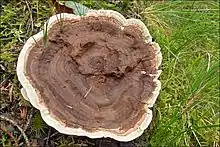Phellodon tomentosus
Phellodon tomentosus, commonly known as the zoned cork hydnum,[1] is a species of tooth fungus in the family Bankeraceae. First described as Hydnum tomentosum by Carl Linnaeus in 1753, it was transferred to the genus Phellodon by Howard James Banker in 1906.[2] It is found in Asia, Europe, and North America.[3]
| Phellodon tomentosus | |
|---|---|
 | |
| Scientific classification | |
| Domain: | Eukaryota |
| Kingdom: | Fungi |
| Division: | Basidiomycota |
| Class: | Agaricomycetes |
| Order: | Thelephorales |
| Family: | Bankeraceae |
| Genus: | Phellodon |
| Species: | P. tomentosus |
| Binomial name | |
| Phellodon tomentosus | |
| Synonyms | |
| |
The brown mushroom's cap is 1.5–5 cm wide, broad, flat, or funnel-shaped,[4] sometimes fused with others, zoned with a white margin,[5] dry, thin, and fragrant-smelling; the taste is mild to bitter.[4] The spines on the undersurface are 1–3 mm long, grayish-brown with pale tips, some running down the upper portion of the stalk.[4] The flesh is brown.[5] The stalk is 1–5 cm tall and 2–5 mm wide.[4] The spores are white and more or less globose and spiny.[4]
The mushroom is inedible.[4]
Similar species include Phellodon atratus, Coltricia cinnamomea, Sarcodon fuscoindicus.[4]
References
- McKnight VB, McKnight KH (1987). A Field Guide to Mushrooms: North America. Peterson Field Guides. Boston, Massachusetts: Houghton Mifflin. p. 98. ISBN 0-395-91090-0.
- Banker HJ. (1906). "A contribution to a revision of the North American Hydnaceae". Memoirs of the Torrey Botanical Club. 12: 99–104 (see p. 171).
- Zhishu B, Zheng G, Taihui L (1993). The Macrofungus Flora of China's Guangdong Province (Chinese University Press). New York, New York: Columbia University Press. p. 112. ISBN 962-201-556-5.
- Davis, R. Michael; Sommer, Robert; Menge, John A. (2012). Field Guide to Mushrooms of Western North America. Berkeley: University of California Press. pp. 284–285. ISBN 978-0-520-95360-4. OCLC 797915861.
- Trudell, Steve; Ammirati, Joe (2009). Mushrooms of the Pacific Northwest. Timber Press Field Guides. Portland, OR: Timber Press. p. 234. ISBN 978-0-88192-935-5.